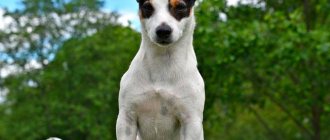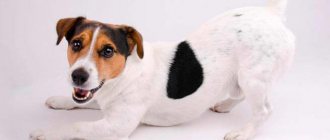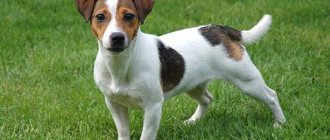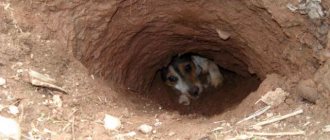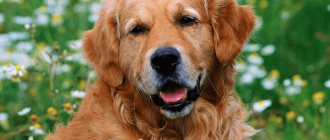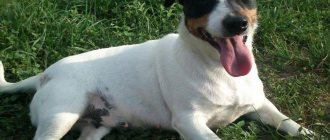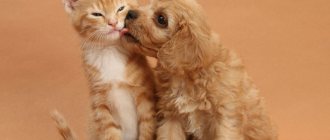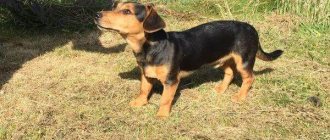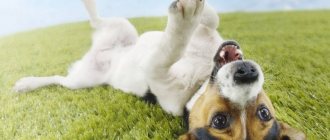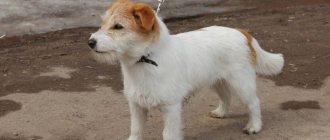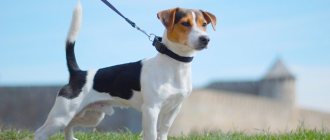One of the characteristics of the Jack Russell Terrier is its very active behavior. Probably everyone remembers the film “The Mask” - it’s not for nothing that the director chose a representative of this breed as the main animal character. And it’s difficult to say whose temperament is more violent – the dog’s or the magic mask’s. Let's find out what other features of the breed those who decide to have a Jack Russell Terrier in their home should know about.
Brief history of origin
The history of the Jack Russell Terrier breed dates back to the 19th century in Great Britain, which became the birthplace of these dogs. The Jack Russell owes its origin to Pastor John Russell, whom his friends called Jack. He was a great lover of hunting, bred fox terriers, also called fox terriers, and for a long time tried to develop the ideal dog for fox hunting.
One day while walking, the pastor saw a dog that, in his opinion, had the features of an ideal hunter, and persuaded the owner to sell it. She got the nickname Trump. All modern representatives of the Jack Russell Terrier and Parson Jack Russell Terrier breeds trace their origins to this dog.
John Russell, and then his followers, wanted to breed a burrowing dog that could race for hours with a pack of hounds and hunters on horseback. The dog must be smart in order to catch up with a meandering pack if necessary, and balanced, capable of making friends with other dogs and horses. For a long time, a breed of dogs adapted for horse-mounted fox hunting was bred, and this breed was called the Parson Jack Russell Terrier. After horse hunting fell out of fashion, breeders began to focus on breeding shorter-legged specimens suitable for hunting on foot in rocky terrain. It was only in 1971 that the breed was officially registered as the Jack Russell Terrier.
Currently, Jack Russell Terriers are rarely used as hunting dogs, but are excellent companions for active owners.
Hunting qualities
Like many other members of the terrier group, Jack Russell Terriers were bred to hunt small, burrow-dwelling game. Of course, terriers do not have enough speed and power for tracking and pursuit, but English foxhounds or other hounds did an excellent job with this task, but in penetrating an underground shelter and in a fight forcing the “fugitive” to leave it, the persistent and compact hounds have no equal strong guys.
Jack Russell exploring the hole
It was already mentioned above that Jack Russell Terriers gained their reputation as excellent burrow dogs not for their ferocity, but for their clear voice and high intelligence. They not only understood the hunters’ strategy in a given situation, focusing on various horn signals, but also made their own decisions, which helped save energy without sacrificing efficiency.
Since their introduction, "jacks" have been an integral part of rural life in Great Britain. However, since 2002 in Scotland, and since 2005 in England and Wales, fox hunting has been officially banned, although for many it was part of the country's cultural heritage. Badgers are also now protected by conservation organizations. In southern Spain there is still a hunting area where it is possible to pursue game on horseback, but in most European countries the tradition is fading into history due to the lack of uninhabited areas with suitable landscape.
But innate instincts cannot be canceled as easily as centuries-old rituals, so four-legged “city dwellers” do not miss the opportunity during a walk to chase a passing cat or dig an impressive hole in the roots of trees from the nearest park.
Interesting facts about Jack Russell Terriers
Despite the fact that this breed originated two centuries ago, it is becoming more and more popular every year. Several interesting facts will help you learn more about this breed:
- Jack Russell Terriers, due to their light color, are susceptible to harmful sun rays and tan very quickly, so owners must stock up on sunscreen for them in the warm season.
- The height to which a Jack Russell Terrier can jump is 5 times its own height. This means that a terrier 30 cm tall is capable of jumping up 1.5 meters.
- A representative of the breed named Botie in 1982 became the first dog to make the transition from the North to the South Pole. True, he did this not alone, but with his masters - British explorers Ranulph and Ginny Fiennes.
- In 1977, a Jack Russell terrier named Vampire in Great Britain set a world record - he killed a whole ton of rats in a year.
- Representatives of the breed are among the ten dogs with the highest level of intelligence. They can draw conclusions by analyzing the data received and choose the best route. That is why these dogs can often be found in the service of customs or police.
Nutritional Features
When feeding Jack Russells, you need to follow 2 rules - the diet must be balanced and you cannot mix natural food and ready-made food.
With a natural diet, the dog's diet should consist of 60% meat and the remaining 40% from dairy products, vegetables and cereals.
Products allowed for Jack Russell:
- lean boiled meat;
- boiled lean sea fish without bones;
- boiled offal;
- dairy and fermented milk products;
- vegetables;
- rice and buckwheat porridge.
It is forbidden to give:
- fatty meats;
- tubular bones;
- freshwater fish;
- spices and herbs;
- corn, beans, potatoes;
- fried, spicy, salty, sweet and smoked foods.
With a natural diet, it is necessary to give your pet additional vitamins and minerals.
In case of feeding with ready-made food, it is necessary to buy only super-premium or holistic food.
Most popular brands:
- Artemis Maximal Dog;
- Innova EVO;
- Royal Canin;
- Hills;
- Bosch;
- Artemis.
Your pet should always have free access to clean, settled or filtered drinking water.
Due to the tendency of these dogs to become obese, it is important to follow a feeding schedule and control portion sizes..
Breed description, standards and appearance
The Jack Russell Terrier is a strong, robust medium-sized dog with a slightly elongated body, and according to the FCI classification it belongs to small terrier breeds. The ears of the Jack Russell Terrier are small, semi-erect, and mobile. Modern Jack Russell Terriers are short-legged dogs with pronounced muscles.
The first breed standard was formulated in Australia in 1971. The first breed club of these terriers appeared there. The FCI approved the modern breed standard only in 2001.
The exact height of representatives of the breed is not specified by the standard, but among breeders the ideal height for males is 27–30 cm, for females 24–27 cm. In adulthood, the size of female Jack Russell Terriers is always slightly smaller than the size of males.
The weight of an adult dog should be proportional to its height. A Jack Russell Terrier dog will look harmonious if for every 5 cm of its height there is 1 kg of its weight. This means that an adult who weighs 5 kg should have a height of 25 cm.
This is interesting! The maximum recorded height and weight of these dogs as adults is 40 cm and 8 kg, respectively.
Allergenicity
Terriers do not pose a particular danger to allergy sufferers, especially since their hair is relatively short. The animal may grow a beard and eyebrows. You will have to carry out the trimming procedure and comb the dog in a timely manner. During trimming, those dead skin particles that cause an allergic reaction are also removed.
If you are prone to allergies, the optimal choice for a pet would be a Jack Russell Terrier with a “gesture” or “broken” coat. And if you are not afraid of shedding, then the smooth-haired Jack Russell Terrier is for you.
Breed standard
The current FCI standard gives the following characteristics to Jack Russell Terriers:
- The skull is flat, tapering slightly from the eyes to the jaw.
- The nose is neat, black, with open and well-developed nostrils.
- The eyes are small, dark brown, almond-shaped, deep-set.
- The ears are mobile, small, hanging on cartilage. Must have V-shaped tips. Jack Russell Terriers have two types of ears: floppy or button ears.
- The jaws are powerful with strong teeth and a scissor bite.
- The neck is strong and quite long.
- The body is oblong.
- The back is strong and straight.
- The chest is deep and not wide.
- Limbs are strong and muscular.
- The paws are round, small, straight set, with elastic pads and tightly clenched toes.
- Based on the type of coat, the following varieties of the breed are distinguished: smooth-haired, wire-haired and intermediate (in English - broken, that is, broken).
- Color – white with multi-colored spots.
- The tail is set high, straight or slightly curved towards the head, thick at the base. Can be docked up to 13 cm in such a way that the remaining part is kept straight.
This is interesting! The length of the docked tail when excited should be equal to the height of the dog's ears.
Miniature Jack Russell Terrier
Currently, you can find advertisements for the sale of dwarf or mini Jack Russell terrier puppies.
As mentioned above, according to the standard, the height of Jack Russells, depending on gender, should be 24–30 cm, weight 5–6 kg. However, some breeders began to breed Jack Russell Terriers of the toy format - weighing no more than 3 kg. Fancier breeders of the Miniature Jack Russell Terrier claim that this is another variety of the breed, but in fact such a variety does not exist.
Indeed, sometimes puppies can be born too small, but this is usually a consequence of premature birth or inherited diseases. Therefore, when purchasing a dwarf representative of this breed, the owner must be prepared for the fact that his pet will have poorer health and will not be able to participate in exhibitions or breeding.
It is important! The lifespan of mini Jack Russells is several times less than that of standard ones.
Can a dog change as it ages?
If we talk about external changes in Jack Russells with age, then there are practically none . If you compare a teenage puppy and an adult dog of this breed, the difference is barely noticeable; the height changes somewhat upward.
But there may be changes in character, but most often this is due to the owner’s behavior towards the pet.
If an animal is treated like a child, then it may begin to do dirty tricks for fun, knowing that nothing will happen for it. The complete absence of any training gives the same effect.
Representatives of this breed need to be carefully handled.
Cruel treatment of a dog can make it aggressive and this is typical not only for Jack Russells, but also for any other breeds.
Very rarely, a surge of aggression can occur for no apparent reason; this most often happens to males aged 5-7 years and goes away on its own.
Coat type and color
Depending on the type of coat, representatives of the breed are divided into the following types:
- smooth-haired: the coat is short, hard, smooth, close to the body and has a developed undercoat;
- Wire-haired or long-haired shaggy Jack Russell Terriers: the hair sticks out in different directions, has a dense structure and forms eyebrows and a small beard on the muzzle;
- Brocken (intermediate coat type): the coat does not look shaggy, like that of wire-haired Jack Russell Terriers, and lies close to the body; These are hairy dogs, but they do not have a mustache or beard, and the hairs of the coat are broken in several places.
This is interesting! The coat type can be determined no earlier than two months of age, because puppies with different coat types are often born in the same litter.
According to the standard, the correct color of the Jack Russell Terrier has only three color options:
- black and white – black spots on a white background;
- white-red – red Jack Russell Terriers have spots on a white background, the color of which can vary from dark brown to red;
- tricolor - black and red spots on a white background.
In purebred individuals with any of the types of colors listed above, white cannot be less than 50% of the total area of the skin, and the spots must have a round shape and not merge with each other.
This is interesting! Solid white Jack Russell Terriers are extremely rare. Terriers with this color are disqualified from exhibitions due to lack of pigment.
Character and behavior
By nature, Jack Russell Terriers are friendly and cheerful dogs. They get along well with all members of the household, without choosing a leader for themselves. They are usually friendly with other pets, but rodents can be seriously harmed by them. Sometimes Jack Russell Terrier boys show aggression towards their relatives and can even get into fights with representatives of larger breeds. Jack Russell Terriers are wary of strangers, but without aggression.
Jack Russell Terriers have a highly developed intelligence and willingly learn new commands and tricks, so even a beginner can easily cope with their training. The main thing is to be patient, praise the dog, do not raise your voice at it and, especially, do not resort to physical force. For peaceful coexistence with household members and other pets, as well as to avoid aggression towards unfamiliar people and animals, socialization of the breed should begin at a very early age.
Read this article about how to properly raise a dog.
One of the characteristics of the Jack Russell Terrier breed is a developed sense of possessiveness. These dogs are very jealous not only of their belongings, but will remain unhappy if the owner pets someone else.
An important feature of the breed is their restless nature. Jack Russell Terriers need constant attention, communication, movement or some kind of activity. Otherwise, the terrier will get bored and begin to spoil things.
Expert opinion
Leonid Rodin
Experienced dog breeder
Ask a Question
This small hunting dog often becomes the cause of major misfortunes in the house: damaged furniture and shoes, torn pillows to shreds. Unfortunately, when buying a Jack Russell Terrier, most owners do not know the characteristics of this breed and focus solely on appearance. But Russell's is deceptive. On the surface, she has a good-natured and lively nature, with attentive, kind eyes, friendly and trusting. But inside lies a real “perpetual motion machine”, which has only one true passion - unbridled movement. Therefore, the first commandment for the owner of a Jack Russell Terrier: long active walks cannot be replaced by any games in the apartment. The dog should run around enough in the park or forest. Even teaching the basic commands “Down!” and “Sit!” you cannot start without the pet expending some of its irrepressible energy. He simply will not be able to concentrate and understand what they want from him. But if he runs a little, but does not reach the point of exhaustion, Russell will be happy to do something good for his beloved owner.
Bad habits
The main reason for the bad habits of the Jack Russell Terrier is a lack of physical and mental stress. All behavioral problems of the breed can be corrected or prevented with the help of competent training and education.
The most common “bad habits” among Jack Russells:
- Excessive barking.
Representatives of the breed love to bark, moving from squealing to loud barking. Jack Russells can do this with or without reason, which can cause conflict with neighbors. Most often, your pet barks out of boredom, so you need to immediately attract its attention with clap or voice. When the dog stops barking, be sure to praise him or give him a treat.
- Stubbornness.
From the first days the puppy is at home, you need to make it clear to him who is the leader in the family. Often Jack Russell Terriers are stubborn, unwilling to obey, if the owner was unable to build a clear hierarchy from the very beginning of their relationship. These dogs can also be stubborn in order to attract the attention of their owners.
- The pursuit.
Chasing other animals, birds, bicycles and people is in the Jack Russell's blood, so you need to teach him the necessary commands, and also not let him off the leash in crowded places.
- Digging.
The origin of the representatives of the breed left its mark on them and made them good diggers. This behavior must be stopped by prohibiting the puppy from digging from early childhood, as well as distracting him with something else.
- Chewing.
Dogs of all breeds and ages have a tendency to chew on various objects. To prevent your dog from spoiling things, you need to offer him special toys or bones, and also pay him more attention.
Jack Russell Terrier and children
Jack Russell Terriers are great with children and will happily communicate with both the owner and strangers. True, you should not leave your dog alone with children under 3 years old - the dog will not tolerate strong hugs or careless handling and may snap back, scaring the child. It is important to teach your pet that the child has a routine, otherwise the dog may wake him up at the wrong time for games and communication. In families with children, these terriers spend almost all their time near them, waiting for new games and entertainment.
Key points in training
Dogs of this breed love to chase small animals.
- This hunter's instinct must be developed and encouraged . A weak-willed person will not be able to cope with training an animal, because the Jack Russell immediately senses “who’s boss.”
- During training, you should never shout at the animal . You cannot hit a dog so as not to provoke retaliatory aggression. All commands must be given in a calm, confident tone.
- Read about how to properly train a dog in the article: “Training a puppy: effective methods from dog handlers, learning commands at home.”
The ideal trainer is a tough, but not cruel, person who knows exactly what he wants from the dog and intends to achieve his goal at all costs. The main thing is regularity of classes.
Care and maintenance
Jack Russell Terriers are an unpretentious breed of dog. They can live in a country house or in an apartment without any problems. However, with the latter option, you need to provide your pet with sufficient physical activity. These active terriers need frequent and long walks - about an hour twice a day, keeping them busy with dog games.
Caring for the coat of representatives of the breed is not difficult - smooth-haired individuals only need to be combed every week with a special rubber mitten, while pets with other types of coat need to be trimmed every three months. The coat of these terriers has the ability to self-clean, so they do not need to be bathed often - it is advisable to do this 3-4 times a year, and also before shows.
It is important! Female Jack Russell Terriers must be bathed after the end of their heat.
For prevention, you can wipe your eyes with a cotton pad soaked in boiled warm water. Teeth should be periodically brushed with toothpastes, and the dog should also be given special bones. Ears should be checked weekly for dirt and cleaned with a cotton pad soaked in a special lotion. Nails need to be trimmed monthly with clippers.
Read more about “How to properly care for the breed and maintain a Jack Russell Terrier.”
To choose a Jack Russell Terrier puppy, you need to study the documents of its parents and observe their behavior. When choosing a puppy, it is very important to pay attention to its appearance and behavior - the baby must be healthy and active. It is advisable to choose a dog from a specialized kennel or from an experienced breeder who cares about the gene pool and education of his pets.
The price of a purebred puppy with all documents and pedigree will be at least 35,000 rubles. Kids without a pedigree will cost 10,000-15,000 rubles. The price of a puppy is greatly influenced by the city of purchase: for example, in Moscow and St. Petersburg they will cost several times more than in other Russian cities.
Caring for puppies
Jack Russells usually give birth to 3–5 puppies in a litter, but some females give birth to 6 puppies. Newborn puppies feed on their mother's milk for the first month of life. After reaching this age, they need to gradually introduce complementary foods.
Jack Russell Terrier weight and height table by month
The age when a dog stops growing is different for each breed. Jack Russells typically grow until they are 11 to 12 months old. To properly assess your puppy's development, you need to carefully monitor its weight and height in the first year of life: use the table below for this:
| Age, months | Weight, kg | Height, cm |
| 1 | 0,7–1 | 8–9 |
| 2 | 2 | 10 |
| 3 | 2,5–3 | 11 |
| 4 | 4 | 12 |
| 5 | 4,1 | 13 |
| 6 | 4,3 | 15 |
| 7 | 4,5 | 17 |
| 8 | 4,6 | 19 |
| 9 | 4,7 | 20 |
| 10 | 4,8 | 22 |
| 11–12 | 5–6 | 25–30 |
It is important! The parameters indicated in the table and the actual dimensions of the puppy may differ by approximately 0.5 cm or several grams. If the height or weight of a Jack Russell Terrier is significantly below the norm, it is imperative to consult a veterinarian.
From one and a half to 4 months, babies grow very actively, gaining height and weight, so their growing bodies require a large amount of nutritious food. If during this period the baby moved to a new home, at first it is advisable to feed the puppy the food that the breeder gave him. After the baby gets comfortable, you can change the type of feeding. If the owner chooses a natural method of feeding at this age, it is necessary to gradually introduce complementary foods into the puppies’ diet.
The Jack Russell Terrier continues to grow its body and internal organs for 4 months. At this age, the puppy's baby teeth fall out and permanent teeth grow, and fur formation also occurs. From 4 to 6 months, the foods in the diet remain the same, but the number of feedings decreases and the volume of portions increases.
You can find out more about your dog’s diet in the article “What to feed your Jack Russell Terrier.”
From 6 to 12 months of age, puppies grow less - at this time their bones become stronger and muscle mass increases, so the calorie content and volume of food can be reduced by reducing the amount of cereal given to the pet.
Feeding table for Jack Russell by month in the first life with a daily menu:
| Age, months | Menu for the day | Number of feedings |
| 0–1 | Mother's milk | 7–8 |
| 1–2 | Milk, soaked dry food, broth | 7 |
| 2–3 | Boiled lean meats, cereals, vegetables, fruits, dairy products | 6 |
| 4–5 | Meat, cereals, vegetables, dairy products, fruits | 4 |
| 6–12 | Meat, fish, cereals, vegetables, dairy products, boiled egg yolk, fruits | 3 |
It is important! After the dog reaches one year of age, it needs to be switched to 2 meals a day.
Caring for a Jack Russell Terrier puppy from the moment it arrives in the house should be carried out according to certain rules:
- The baby’s place should be away from heat sources and drafts;
- it is necessary to purchase a sufficient number of toys for the puppy, which will be located next to his bed, as well as bowls, a leash, a muzzle, and a massage mitten;
- You can only walk your Jack Russell Terrier puppy on a leash;
- up to a year old, small Jack Russells should not go down stairs due to the risk of damage to their elbow joints;
- puppies can be walked only after they have received all the necessary vaccinations;
- you should not wake the baby unless necessary, since sleep is important for the formation of his nervous system;
- Until 5 months, Jack Russell puppies should not be left alone - at this age they find it difficult to tolerate loneliness, perceiving it as punishment.
It is important! You should not play games like tug-of-war with puppies - this can lead to the formation of malocclusions.
To what age do they grow?
The age at which a dog stops growing is different for all breeds.
Jack Russells stop growing when they reach 11-12 months of age . If your dog has stopped gaining at least a centimeter in height per month, then this is a reason to sound the alarm.
Most likely he is not receiving any nutrients, due to which his growth hormone is not activated.
This development of events cannot be favorable for the dog, so contact your veterinarian to find out the cause of this anomaly and correct the situation as soon as possible.
Vaccinations and susceptibility to disease
The Jack Russell Terrier is one of the ten longest-living dogs, their life expectancy is on average 14–16 years.
They are considered a breed with good health, but are still susceptible to some “breed” diseases:
- allergy;
- hip dysplasia;
- diabetes;
- cardiovascular diseases;
- cataract;
- dislocation of the kneecap;
- Perthes disease (damage to the head of the femur);
- congenital deafness.
In addition to all grooming procedures, it is necessary to vaccinate representatives of the breed from a very early age. Newborn Jack Russell Terrier puppies gain immunity from their mother's milk, but this disappears by about two months of age. At this time, the puppy needs to have its first vaccination, before which mandatory deworming is carried out.
It is important! Before administering the vaccination, the veterinarian must provide the owner with information about the name of the vaccine and its expiration date.
Vaccinations for puppies of this breed are carried out strictly according to schedule. The Jack Russell Terrier vaccination table by age will make life easier for an inexperienced dog breeder:
| Age | Disease |
| 8–9 weeks | Canine distemper (distemper), leptospirosis, hepatitis, parainfluenza, parvovirus enteritis |
| 12–14 weeks | Canine distemper, leptospirosis, hepatitis, parainfluenza, parvovirus enteritis + rabies |
| 12 months | Canine distemper, leptospirosis, hepatitis, parainfluenza, parvovirus enteritis + rabies |
In the future, the pet is vaccinated annually with complex vaccines against rabies and other deadly infections.
Education and training
Jack Russells are smart, quick-witted and have a good memory, but the training process is complicated by their innate stubbornness and cunning.
It is necessary to start raising and training your pet from an early age, immediately letting him understand who is in charge in the house and what is allowed and what is not..
It is important to maintain consistency and stability, training must be regular, and patience and perseverance are required from the owner.
It is best to raise a dog in a playful way; you cannot beat it; if punishment is required, you can take the animal by the withers and shake it.
The Jack Russell needs to learn commands such as “come”, “place”, “sit”, “lie”, “near”, “fu”, “give” and “fetch”.
The main pros and cons of the breed
Owners of these terriers, in addition to the bad habits of their pets, may encounter the following problems of the Jack Russell Terrier breed. But undoubtedly, this breed has many more advantages.
| pros | Minuses |
| Possibility to be kept in a small apartment due to its compact size | The need for active and long walks |
| Developed intelligence | Heavy shedding in smooth-haired individuals |
| Excellent learning ability | Male Jack Russell Terriers are often aggressive towards other dogs |
| Unpretentiousness | |
| Good security qualities |
This is interesting! Jack Russell Terriers are often used in canis therapy - they help improve the condition of children with autism, cerebral palsy and other disorders.
The Jack Russell Terrier, despite all its bad habits, will definitely become the main favorite of the whole family and the best friend of children. The owners only need, in addition to standard care, to pay more attention to their pet, often playing, walking and simply communicating with him.
